Worthington Cone 06-2 Clear
Gelling, High LOI, Gerstley Borate difficult to sub, High Boron
|
Code # G2931 |
Batch # -2 |
| Materials | Amt |
|---|---|
| Gerstley Borate | 55.000 |
| EPK | 30.000 |
| Silica | 15.000 |
Total:100.00
Auto Unity Formula
|
Si:Al: 5.3:1 6.5 (Molar:6.6) 20.7 Cost 0.00 per kg |
Notes
This recipe is a common Gerstley Borate clear base used from 04 all the way to cone 6! At higher temperatures the recipe trends toward less kaolin to more silica and a little less GB (e.g. 50:20:30).
Attractions its simple make-up and crystal clear fired result (low bubble population). Although it can also fire with clouding, variegation and boron blue depending on thickness, the clay body and firing.
The high boron content of Gerstley Borate, enabling high melt fluidity, make this glaze possible. Potters use it on terra cotta, talc and stoneware bodies that generate lots of gases of decomposition and this can often pass and heal bubbles well. High boron clear glazes like this are known for clouding issues (because of micro bubbles) but this has a low enough surface tension to pass them.
Problems with this recipe:
Obviously, if it melts well already at cone 04 great care is going to be needed at cone 2 to prevent it running onto shelves. Highly melt fluid glazes (that have high boron like this) are also more likely to be leachable and to crystallize on cooling (producing the boron-blue clouds).
Paramount is the dreadful problem of gelling. Even with only 1.4 specific gravity (about equal weights of dry material and water and deflocculation with Darvan) it gels badly. The high water content needed and the nature of GB means that glazed ware dries extremely slowly, the glaze shrinks and cracks during drying and crawls during firing. Gerstley Borate is very plastic, yet to make matters worse, the recipe has an additional 30% clay on top of that! This recipe can actually be thrown on a potters wheel!
The thermal expansion is too low for talc bodies, it will shiver on them.
Pictures
Worthinton Clear at cone 01

On a terra cotta clay at this temperature was has stoneware properties. The fired surface is good.
Worthington Clear vs. Fritted Clear

Worthington (right) flows even better than the fritted glaze and does not have any more entrained bubbles even though it has an LOI of 20%. This is likely because its melting history and behavior is such that its ability handle gases of decomposition from the body and its own materials is so much better.
2931 vs 2931b
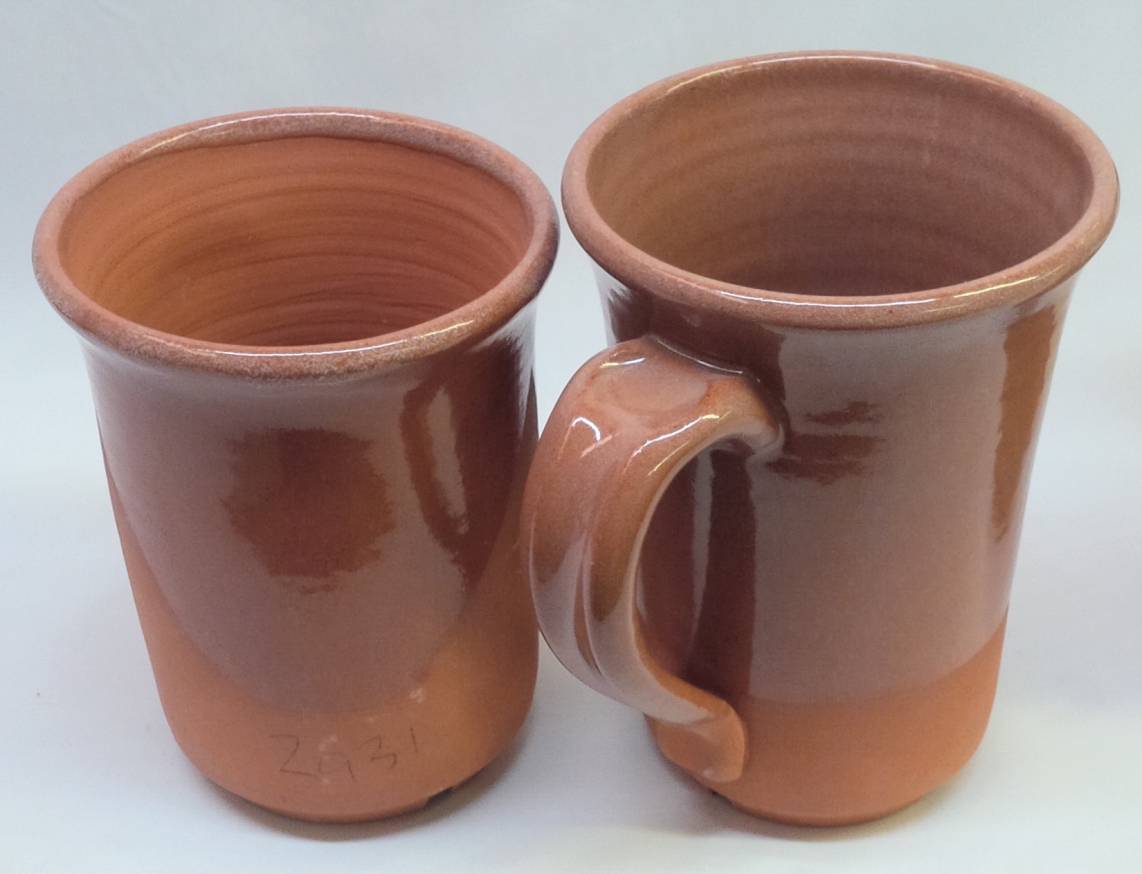
On Plainsman L215 cone 02 the original base Worthington Clear has gone on very thin on sides of mug (because of the low specific gravity necessary to prevent it from gelling it is very difficult to get it on thick enough). The fired surface is clear but not as glossy. On the rim it has bubbles. The Ulexite version (G2931B) is glossier, and went on thicker because the slurry is so much easier to use. This glaze is not recommend for L215, the latter contains talc that increases its thermal expansion, putting too much squeeze on this glaze.
Entrained bubbles in Worthington Clear
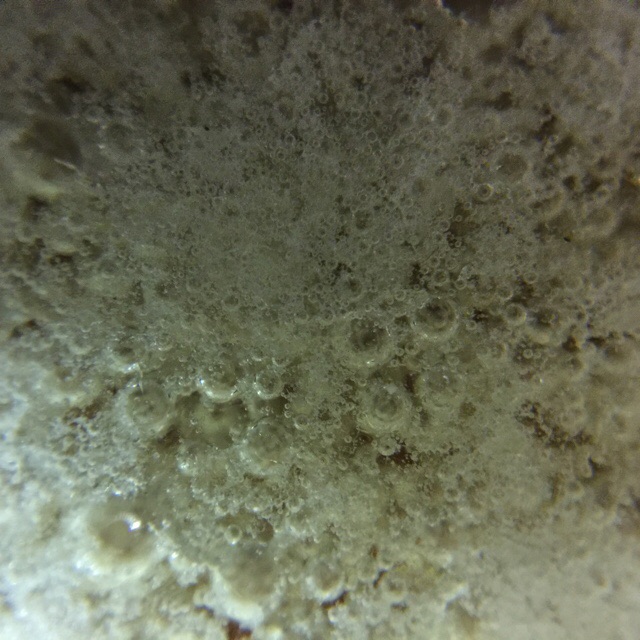
This is a 16X closeup of flow test (10 gram ball melted down onto a tile) that concentrates bubbles. There are high populations of large and tiny ones. The larger ones are from the Gerstley Borate, the tiny ones from the kaolin.
GB vs Ulexite Clear glaze bubbles

These are 10 gram balls fired down onto tiles at cone 04 to compare melt fluidity and bubble populations in three clear glazes. Larger bubbles are better, they break at the glaze surface and heal. Tiny ones produce cloudiness.
Left: The original Worthington fluid melt clear glaze recipe. There are clusters of tiny bubbles and many large.
Center: A glaze of the same chemistry but sourcing its boron from Ulexite instead. Notice the lack of tiny bubbles. This fires pretty well identical to the original but has much better slurry properties.
Right: Center with with a 10% addition of lead bisilicate frit. This fires more glossy than either of the other two. Its thermal expansion is also likely lower.
Worthington Clear the next day

Even though this has a low specific gravity and is deflocculated with darvan, the next day it is still jelly. Impossible to use unless more Darvan is added, who knows where that will go!
G2922G, G2931 flow tests

Testdata
SHAB - Shrinkage/Absorption
| DLEN | DSHR | FSHR | ABS | |
| 1 | 92.24 | 7.8% | ||
| 2 | 92.11 | 7.9% |
LDW - LOI/Density/Water Content
| WWGT | DWGT | H2O | LOI | DENS | |
| 1 | 13.52 | 10.26 | 24.1% |
XML (to paste into Insight)
<?xml version="1.0"?> <recipes version="1.0" encoding="UTF-8"> <recipe name="Worthington Cone 06-2 Clear" keywords="Gelling, High LOI, Gerstley Borate difficult to sub, High Boron" id="56711" key="vfBaGAgn" date="2025-04-06" codenum="G2931" picturebasename=""> <recipelines> <recipeline material="Gerstley Borate" amount="55.000" tolerance=""/> <recipeline material="EPK" amount="30.000" tolerance=""/> <recipeline material="Silica" amount="15.000" tolerance=""/> </recipelines> </recipe> </recipes>
Born: 2014-03-17, Modified: 2025-04-06 20:26:29
Zero3 K Cone 03 Transparent Glaze
|
Code # G2931K |
Batch # -2 |
| Materials | Amt | |
|---|---|---|
| Ferro Frit 3195 | 25.000 | 26.32% |
| Ferro Frit 3134 | 33.000 | 34.74% |
| EPK | 20.000 | 21.05% |
| Ferro Frit 3249 | 10.000 | 10.53% |
| Ferro Frit 3110 | 7.000 | 7.37% |
Total:95.00
Auto Unity Formula
|
Si:Al: 6.1:1 7.4 (Molar:7.5) 3.1 Cost 0.00 per kg |
Notes
This recipe improved on the popular Worthington Gerstley-Borate-based low fire clear recipe. It targeted cone 03 to work best on Zero3 stoneware and porcelain. To fire lower (cone 06-04), consider G1916Q (or derivatives) instead.
Unlike its Worthington Clear predecessor, this does not become a bucket of jelly, does not crack on drying, does not go on unevenly or the wrong thickness, does not cloud up with boron blue or micro-bubbles when fired (because it has lower CaO) when used on the types of bodies discussed below. It is crystal clear and super glassy at cone 03.
If you liked the variegated appearance of the GB version, titanium dioxide can be added to this to produce even better variegation. For darker color rutile with do the same.
Low fire bodies span a wide range of thermal expansions. While Worthington clear (an ancestor of this recipe) melts to a good clear, its thermal expansion was too low. This recipe, G2931K, raises thermal expansion (by adding Na2O). The thermal expansion of Zero3 stoneware and porcelain are about the middle of the range, and they develop good glaze:glaze interfaces, so this recipe fits them well.
This glaze shivers on high-talc bodies and can craze on zero-talc porous ones. This recipe has three variations we have worked with, one of higher expansion (G2931H) and one of lower expansion (G2931L). Keep in mind that adding zircon and stains changes expansion.
Dipping ware in Zero3 Transparent is just so much easier than trying to paint on commercial, slow-drying clears. For us it naturally gels to a creamy consistency at around 1.53 specific gravity (in our circumstances). However it goes on too thick at that high a value, we have found the best all-around performance at 1.43 with enough Epsom Salts to gel it back up to a creamy thixotropic consistency (a few grams per gallon).
Pay special attention to the drop-and-hold firing schedule, especially if your clay body is not fine-grained. Use 04DSDH as a model.
To mix up 5 Kg use about 4.5 kg of water to get 6.5 litres of dipping glaze. To make a brushing glaze: For each 100g of powder mix start with 125 water, 1.5 CMC gum and 1.5 Veegum and thoroughly mix in a kitchen blender (add water if it gels too much). We find the about 330g of powder produces a 500ml (about 1 pint) jar.
To make colored versions add stains as needed (if stains cause micro-bubbling or orange peel surface include 2-3% zircopax).
Batch Ticket Notes
These notes were entered in the notes panel under "Batch Ticket Notes"
Pictures
G2931K on Zero3 Stoneware

Fired cone 03. Body is Zero3 stoneware.
Surface is perfect, even where thick. Ultra clear.
Survived three boil:ice cycles and one 300F:ice cycle without crazing.
G2931F vs. G2931K on Polar Ice Low Fire

2931F was the Ulexite flused version of this recipe. The F survived three boil:ice cycles and 1 300F:ice cycle without crazing or shivering.
The K is slightly smoother, tiny dimples in the surface are fewer. It is also applied thicker.
G2931F vs G2931K fritted - terra cotta mugs cone 03

F was the Ulexite-fluxed version of this recipe.
G2931F vs G2931K flow test
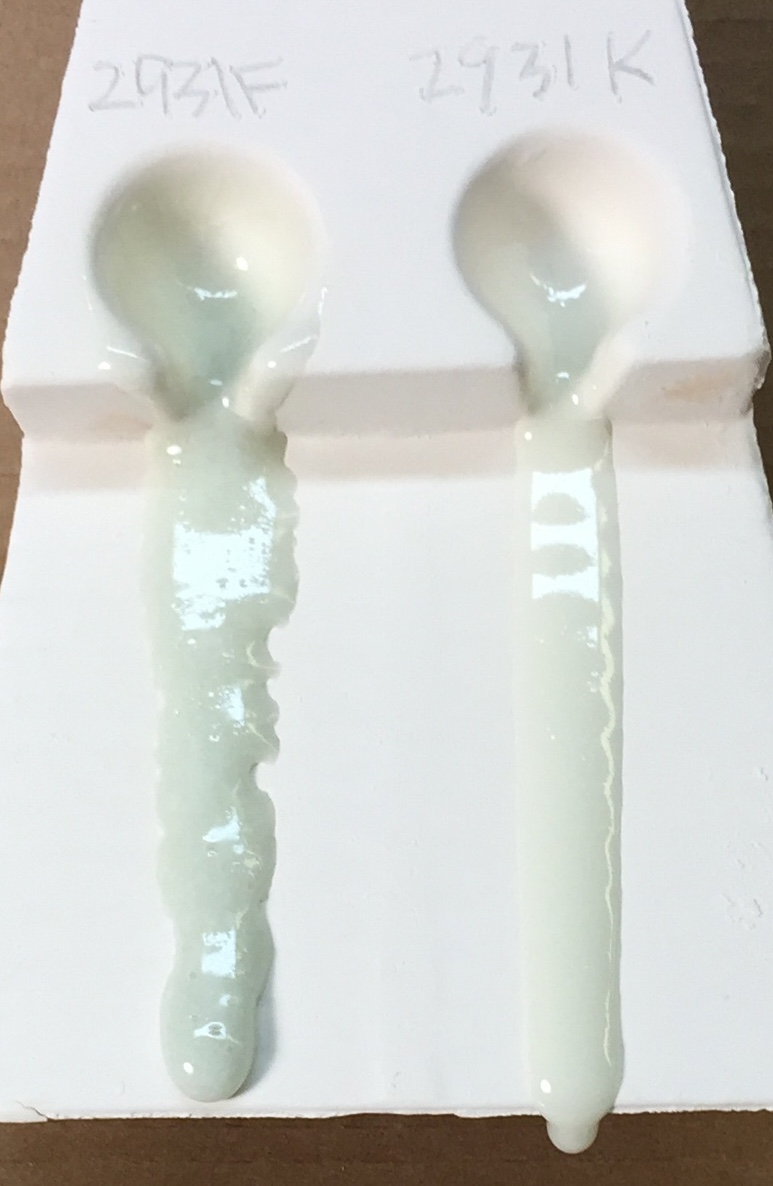
These two recipes have the same chemistry, but K sources boron from frits rather than Ulexite. Notice how much less bubbles there are in the flow and how much more predictable the melting pattern is.
G2931F vs G2931K - Melted balls at cone 03

F, the Ulexite version, is obviously bubbling more, the percolation is causing the melt to spread out more on the tile. On the flow test is was less fluid.
Firing temperature is important for Zero3 glaze

This is G2931F on Plainsman Buffstone, L213, F100, L215. First column is cone 04, center is cone 03, right is cone 02. All exited the kiln without crazing except Buffstone at cone 04.
We subjected all of them to a 300F:IceWater thermal shock.
Buffstone crazed on all of them.
L215 and L212 Cone 04 crazed.
L213 was good but later the glaze was found to be under excessive compression, subject to shivering over underglazes.
At cone 02 there are some dimples and defects.
Three low fire bodies that need three clear glazes
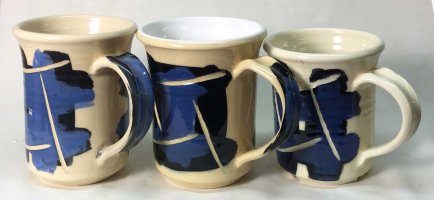
Because of glaze fit. Left: Plainsman Buffstone, contains no talc, fires buff. Center: L212 (about 25% talc). Right: L213 (about 45% talc, fires whiter). Talc raises thermal expansion. The centre glaze is G2931K (Insight-live reports COE 7.4), it fits L215 (also Zero3 porcelain and stoneware). It crazes on Buffstone and shivers on L213 and L212. G2931L has lower expansion (to work on zero-talc porous bodies). G2931H is higher (for talc bodies like L213).
G2931K glaze precipitates things on storage

G2931K On L212 after a year

Some crazing starting.
K on L215 at cone 04

The thicker version is clouding. The thinner one has micro-pinholes. It needs a higher temperature.
G2931K o L215 - Cone 03, thick application

G2931K on L215 - Cone 03 fired in 30 minutes
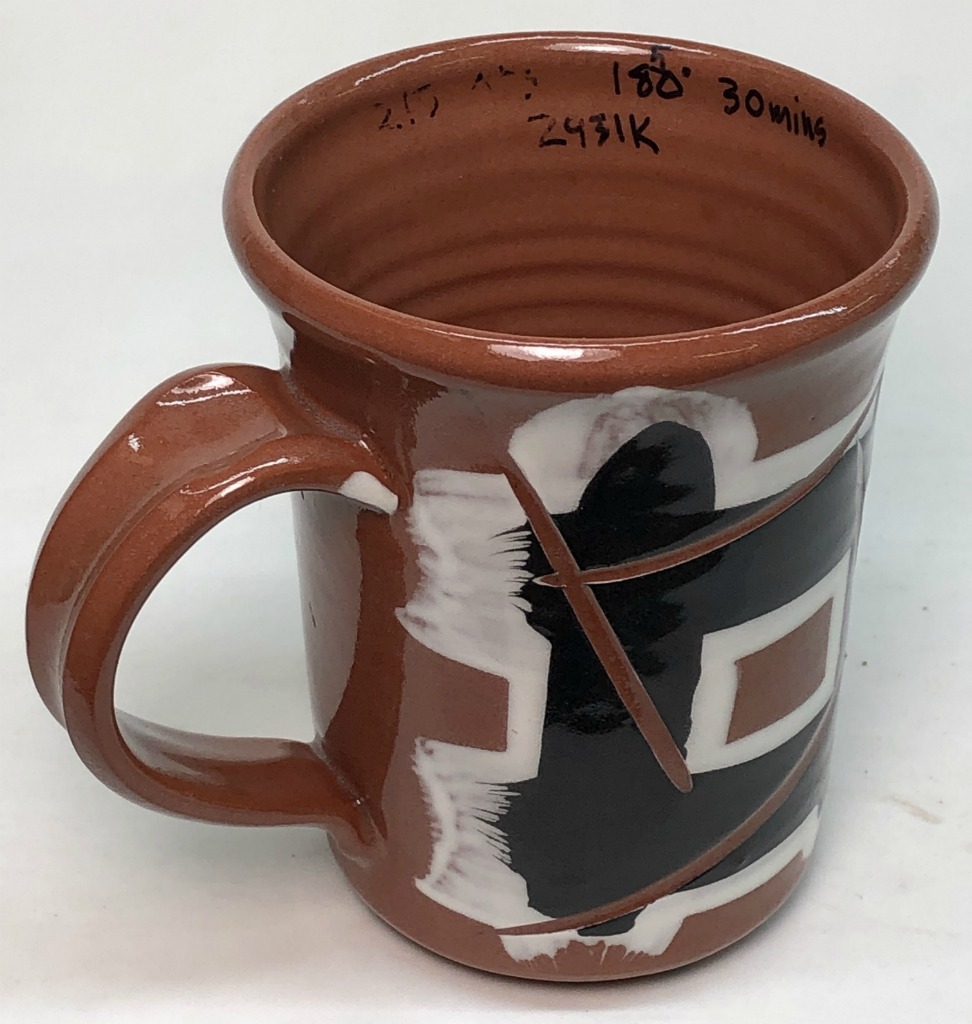
Very transparent. No crazingafter many months.
G2931K on L215 - Cone 06

Milky (because cone 06 is underfired for this glaze). But only a little crazing after a year.
G2931K running on Zero3 Casting

This happened at cone 03 and 04. The G3879 (left) did not run. For some reason G2931K easy applies to thickly on this body.
This 1000 gram batch of glaze powde
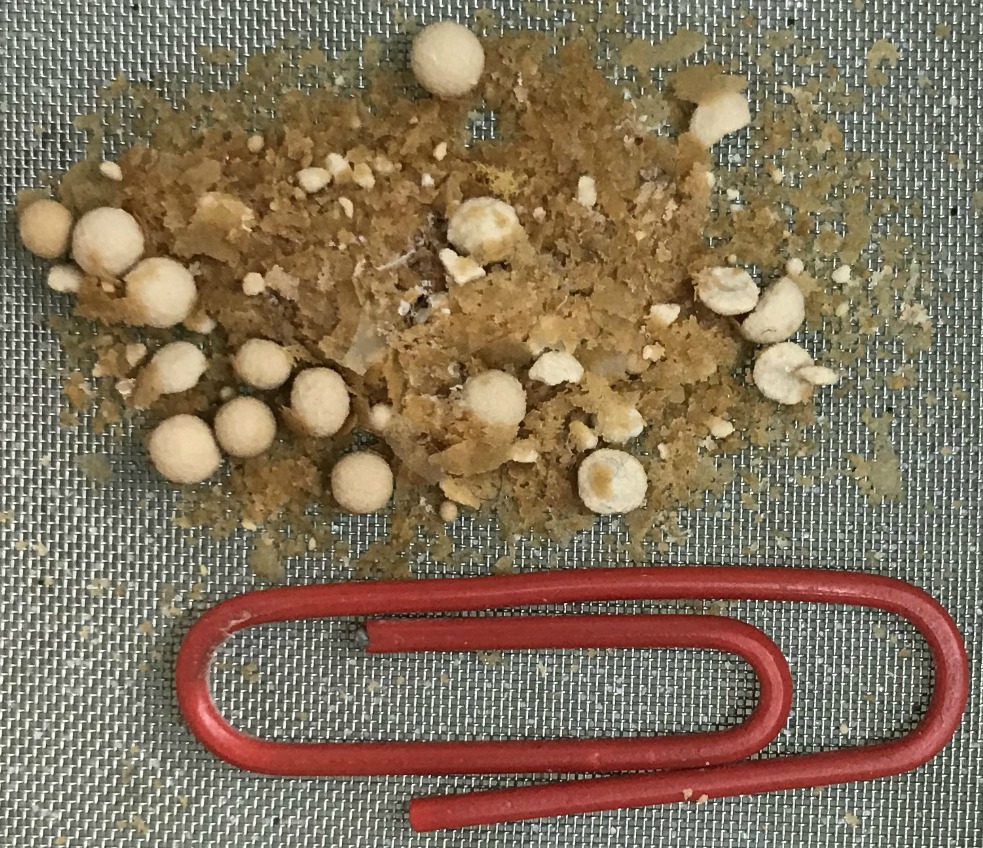
This 1000 gram batch of glaze powder screened 80 mesh immediately after making, and allowed to sit for 3 months prior to usage.
The material in photo was screened out once again after the 3 month time lapse, (80 mesh once again).
The largest balls are approx. 2.5 mm. in diameter, and when these particles were screened out, and still perhaps slightly wet?, they were quite easy to break in half with your fingernail.
G1916Q (left) vs G2931K (right) at cone 04

On a terra cotta body, the G1916Q is performing better, there are less micro bubbles.
URLs
How to tune the thixotropy of a glaze
How to convert a d..o a brushing glaze
Typecodes
ST-Untitled typecode
Alternate Code Number:GS04-1
XML (to paste into Insight)
<?xml version="1.0"?> <recipes version="1.0" encoding="UTF-8"> <recipe name="Zero3 K Cone 03 Transparent Glaze" id="95671" key="1v6bBrdp" date="2023-05-03" typecodes="ST" codenum="G2931K" picturebasename=""> <recipelines> <recipeline material="Ferro Frit 3195" amount="25.000" tolerance=""/> <recipeline material="Ferro Frit 3134" amount="33.000" tolerance=""/> <recipeline material="EPK" amount="20.000" tolerance=""/> <recipeline material="Ferro Frit 3249" amount="10.000" tolerance=""/> <recipeline material="Ferro Frit 3110" amount="7.000" tolerance=""/> </recipelines> </recipe> </recipes>
Born: 2006-03-16, Modified: 2023-05-03 20:54:14
Cone 04+ UltraClear Glossy Base
|
Code # G3879 |
Batch # -2 |
| Materials | Amt | |
|---|---|---|
| Fusion Frit F-524 | 850.000 | 82.93% |
| Fusion Frit F-69 | 40.000 | 3.90% |
| EPK | 90.000 | 8.78% |
| Silica | 45.000 | 4.39% |
Total:1,025.00
Auto Unity Formula
|
Si:Al: 8.4:1 6.5 (Molar:6.1) 1.3 Cost 0.00 per kg |
Notes
We developed this for cone 06-04 to fit many clay bodies (without crazing), melt well at cone 05 and produce a more transparent glaze (rather than the amber of G2931K and G1916Q). The frit F-524 in this recipe is uncommon among potters but common in industry, it is high quality. We later adjusted this recipe to produce variations (e.g. with whiter kaolin, more of the frit F-69 to get a lower thermal expansion).
We found the inspiration for this on testing many commercial clears and finding one that stood above the others regarding fit and clarity at 04 (we had it analyzed and reverse-engineered it using the materials we have). Frit F-524 is expensive, but this glaze is heads-above a number of commercial clear glazes we have tested (they are not ultra-clear, they pinhole or blister or craze, they are not glossy enough, they do not have dipping versions, they are not adjustable). The F-69 is also expensive, but it enables fitting this to any body.
Additions of tin and zircon produce a white that melts just as well as the clear. To make bright-colored glazes this should be an excellent base (remember, this is the clear glaze recipe currently used by at least one commercial supplier of bright-colored glazes). Encapsulated stains are fantastic at low fire and they can be mixed to fine-tune the color. If you are targeting a specific or exotic color then the ability to achieve it will be determined by your ability to source an exotic stain!
The melt is very mobile at 04 yet not significantly more mobile at cone 1 (even up to cone 2). And it has the amount of SiO2 and Al2O3 that a cone 6 glaze has yet melts well at 06! There is some kind of magic with this chemistry!
It hardens to a powdery surface, some gum solution is required to make it dry hard for dipping (for each 100g of powder mix start with 73g water and 7g Laguna gum solution). To make a brushing glaze: For each 100g of powder mix start with 125 water, 1.5 CMC gum and 1.5 Veegum and blender mix (add water if it gels too much). We find the about 330g of powder produces a 500ml (about 1 pint) jar.
This recipe also has implied adjustability (by increasing the low expansion Frit F-69 at the expense of Frit F-524).
Pictures
G3879 Clear glaze on Plainsman L211 - Cone 04
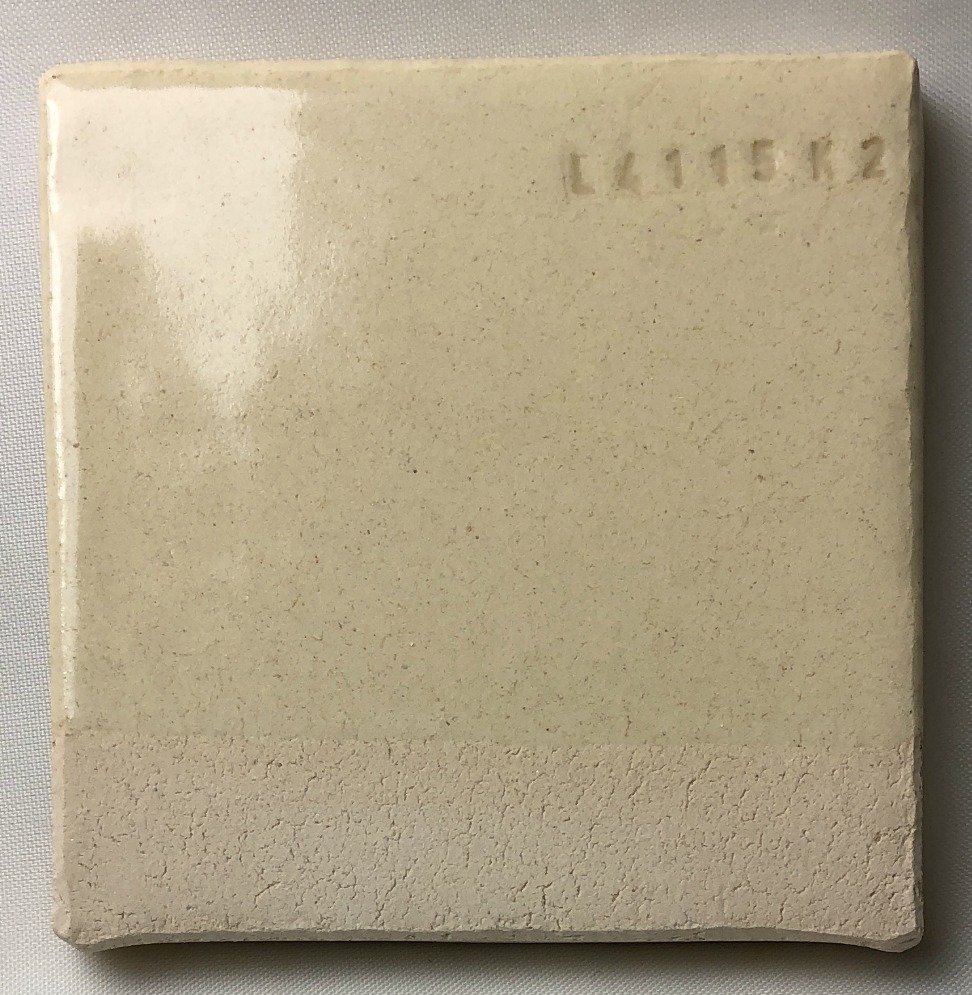
Glossy, crystal clear, no crazing! And this is a 42 mesh body containing zero talc.
Melt fluidity comparison with #1 commercial clear

We tested half-a-dozen commercial clears and found G3859 to be the best all-around one. This one has a very similar melt fluidity.
G3879 on Plainsman L210, L215 at cone 04

These are 42 mesh low fire bodies. They normally have issues with pinholing but using this glaze the results are stunning. The L210 contains no talc, the L215 has 10%, yet this glaze does not craze on either one (over time it shivers on the L215).
G3879 on SIAL 25F, Plainsman J2, L4170 TerraCotta

These are very different bodies. The leftmost contains talc to raise the thermal expanison to help prevent crazing with commercial glazes. The center one contains nepheline syenite (for the same purpose). The terra cotta on the right is just Redart and ball clay. This glaze fits are all three!
After a year, both the 25F and J2 were difficult to break, very strong!
Sial 10F, 25F with G3879 clear glaze at cone 03

Tile like these were done on a variety of bodies and fired at different temperatures. After a year:
Sial 10F
Cone 02: No crazing
Cone 04: Moderate crazing over time
Cone 06: Severe crazing
Cone 03: No crazing
Sial 25F
Cone 1: No crazing
Cone 03: No crazing
Cone 04: Crazing badly
L215
Cone 04: No crazing
L210
Cone 04: No crazing
L212
Cone 04: Crazing
Cone 1: No crazing
L213
Cone 04: No crazing
G3879 Clear on L4170 TerraCotta Casting

The clear glaze is G3879. The white on the outside of the one on the left has 10% added zircopax. The overglaze colors are Spectrum Majolica colors.
G3879 with 5% Tin Oxide on SIAL 10F
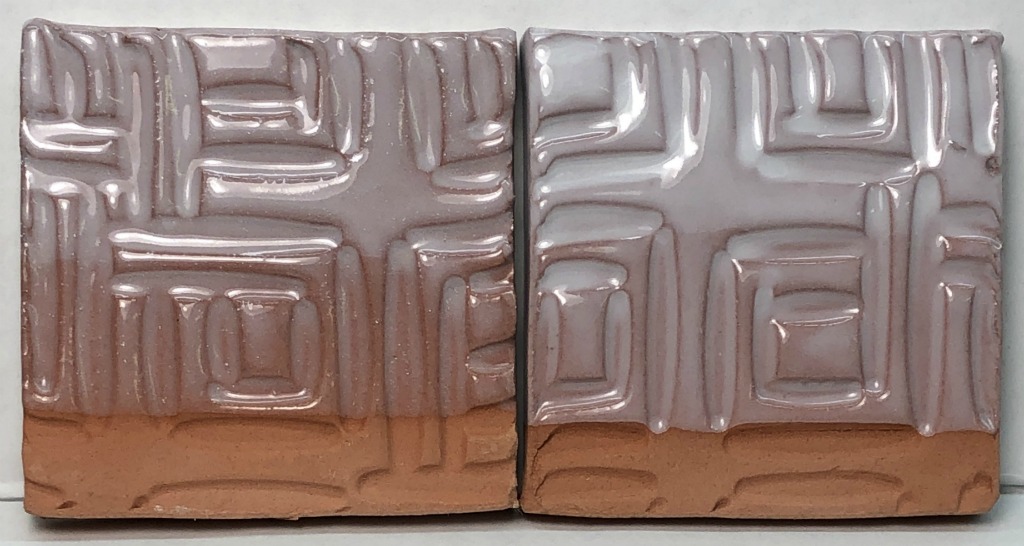
When mixing Tin (as an opacifer), it is very important to mix it well. The one on the left was mixed poorly (at high speed with my propeller mixer but not for long enough). The one on the right was mixed much better and so produces better opacity. Tin is expensive so this is important.
This was not crazed after a year (cone 03).
G3879 on Plainsman Buffstone - cone 03

Buffstone is an entry-level low-price body not intended to fit commercial glazes. Yet this glaze fits at cone 03 (still fitting after a year)! And without any surface defects.
At cone 04 it does craze over time.
G3879 Zircon White on SIAL 25F, 10F - cone 03
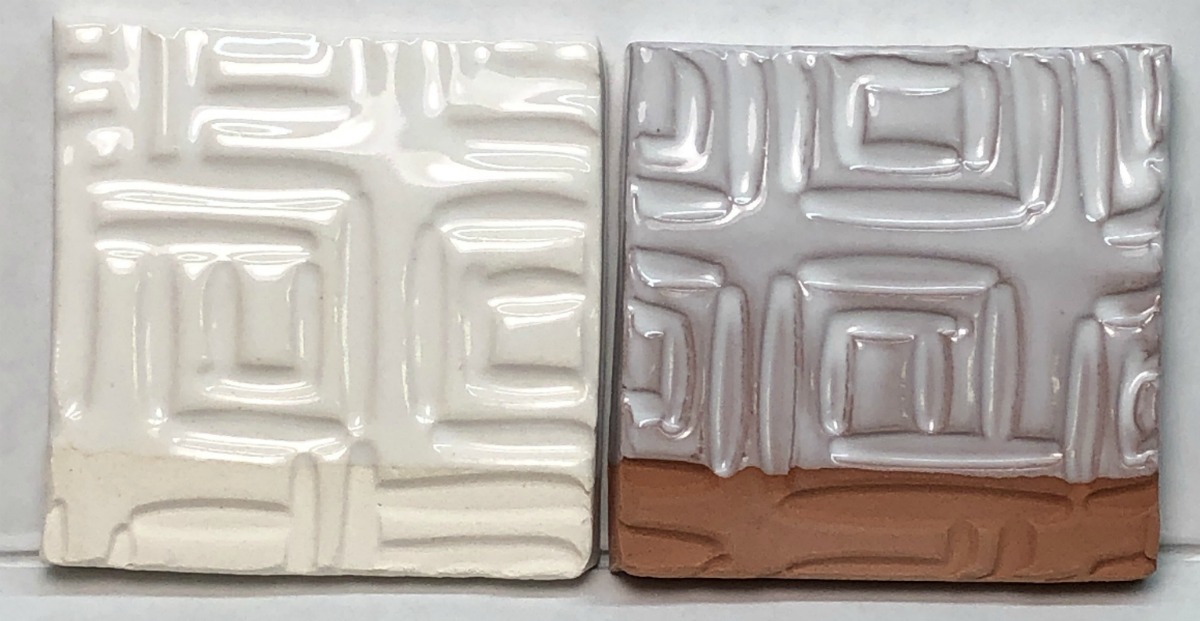
10% zircopax has been added. It is melting well so the percentage could be increased for great opacity on red burning bodies.
G3879 at cone 1 on SIAL 10F, 25F

Crystal clear, no running. Perfect!
GBMF test on G3879 at cone 1

It is not running and flowing nearly as much as expected. The melt surface tension holds it in place, so it should be able to fire to cone 2 and beyond.
G3879 on terra cotta at cone 04, 02, 1

This is on the L4170 body, it is a lighter firing product, 25F, from SIAL. After use on various bodies, it was clear that fit at cone 03 is better than at 04 and much better than 06.
G1916M, G3879, G2931K on L215 - Thick

Thickly applied encourage poor fit to show up.
Clearly, as shivering and cracking demonstrate, G3879 is under excessive compressive on L215.
The other two are not showing any issues (other than heavy bubbling because of the thickness).
G1216M is a blend of 3124/3124 with kaolin. G2931K is the Zero3 clear.
L213 with G3879 glaze at cone 04

Survived 325F:IceWater test with almost no crazing. However there was a little shivering on the rim after a month. Another mug had no crazing on the inside after several months.
G3879 on L4115J2 buff body at cone 04
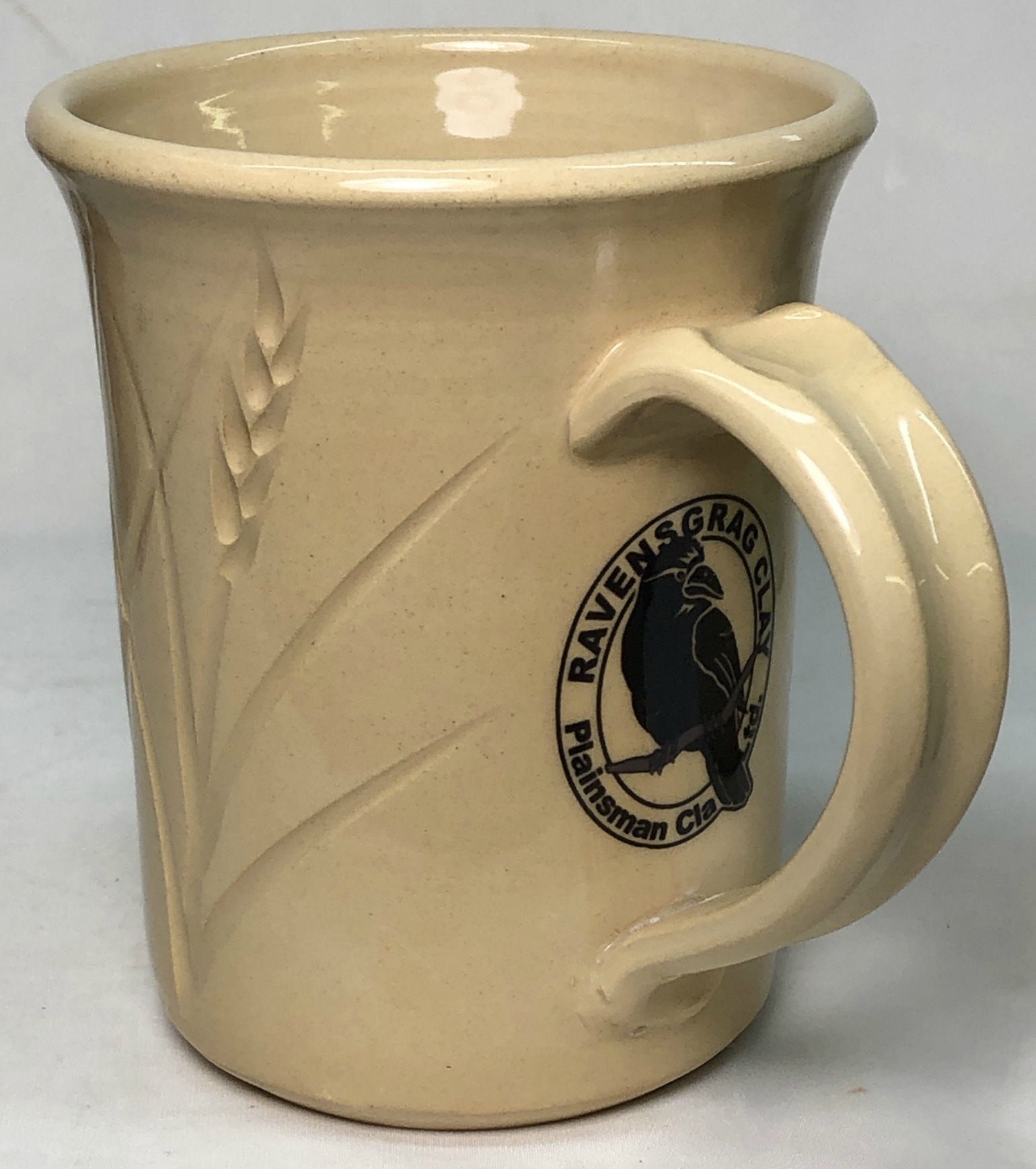
Glaze is ultra clear.
It was refired at cone 022 to apply a decal.
It was 325F to icewater tested without crazing.
It was waterlogged (the bottom is bare clay) and then put in a microwave for two minutes. Despite getting incredibly hot it did not fracture or craze! Was still fitting after a year+.
G3879 on SIAL 10F at cone 02

No crazing after several months. Flawless service.
Variations
B - Tin White
XML (to paste into Insight)
<?xml version="1.0"?> <recipes version="1.0" encoding="UTF-8"> <recipe name="Cone 04+ UltraClear Glossy Base" id="154451" key="KXx42cbC" date="2025-04-06" codenum="G3879"> <recipelines> <recipeline material="Fusion Frit F-524" amount="850.000" tolerance=""/> <recipeline material="Fusion Frit F-69" amount="40.000" tolerance=""/> <recipeline material="EPK" amount="90.000" tolerance=""/> <recipeline material="Silica" amount="45.000" tolerance=""/> </recipelines> </recipe> </recipes>
Born: 2019-04-15, Modified: 2025-04-06 20:40:46
